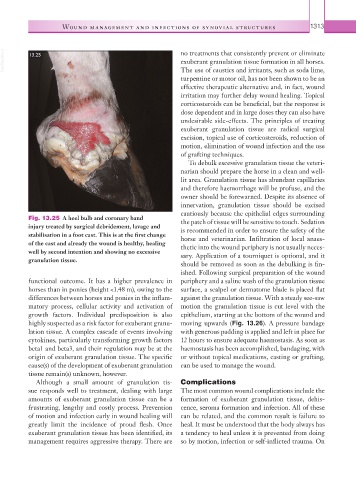Page 1338 - Equine Clinical Medicine, Surgery and Reproduction, 2nd Edition
P. 1338
Wound management and infections of synovial structures 1313
VetBooks.ir 13.25 no treatments that consistently prevent or eliminate
exuberant granulation tissue formation in all horses.
The use of caustics and irritants, such as soda lime,
turpentine or motor oil, has not been shown to be an
effective therapeutic alternative and, in fact, wound
irritation may further delay wound healing. Topical
corticosteroids can be beneficial, but the response is
dose dependent and in large doses they can also have
undesirable side-effects. The principles of treating
exuberant granulation tissue are radical surgical
excision, topical use of corticosteroids, reduction of
motion, elimination of wound infection and the use
of grafting techniques.
To debulk excessive granulation tissue the veteri-
narian should prepare the horse in a clean and well-
lit area. Granulation tissue has abundant capillaries
and therefore haemorrhage will be profuse, and the
owner should be forewarned. Despite its absence of
innervation, granulation tissue should be excised
cautiously because the epithelial edges surrounding
Fig. 13.25 A heel bulb and coronary band the patch of tissue will be sensitive to touch. Sedation
injury treated by surgical debridement, lavage and is recommended in order to ensure the safety of the
stabilisation in a foot cast. This is at the first change horse and veterinarian. Infiltration of local anaes-
of the cast and already the wound is healthy, healing thetic into the wound periphery is not usually neces-
well by second intention and showing no excessive sary. Application of a tourniquet is optional, and it
granulation tissue.
should be removed as soon as the debulking is fin-
ished. Following surgical preparation of the wound
functional outcome. It has a higher prevalence in periphery and a saline wash of the granulation tissue
horses than in ponies (height <1.48 m), owing to the surface, a scalpel or dermatome blade is placed flat
differences between horses and ponies in the inflam- against the granulation tissue. With a steady see-saw
matory process, cellular activity and activation of motion the granulation tissue is cut level with the
growth factors. Individual predisposition is also epithelium, starting at the bottom of the wound and
highly suspected as a risk factor for exuberant granu- moving upwards (Fig. 13.26). A pressure bandage
lation tissue. A complex cascade of events involving with generous padding is applied and left in place for
cytokines, particularly transforming growth factors 12 hours to ensure adequate haemostasis. As soon as
beta1 and beta3, and their regulation may be at the haemostasis has been accomplished, bandaging, with
origin of exuberant granulation tissue. The specific or without topical medications, casting or grafting,
cause(s) of the development of exuberant granulation can be used to manage the wound.
tissue remain(s) unknown, however.
Although a small amount of granulation tis- Complications
sue responds well to treatment, dealing with large The most common wound complications include the
amounts of exuberant granulation tissue can be a formation of exuberant granulation tissue, dehis-
frustrating, lengthy and costly process. Prevention cence, seroma formation and infection. All of these
of motion and infection early in wound healing will can be related, and the common result is failure to
greatly limit the incidence of proud flesh. Once heal. It must be understood that the body always has
exuberant granulation tissue has been identified, its a tendency to heal unless it is prevented from doing
management requires aggressive therapy. There are so by motion, infection or self-inflicted trauma. On

